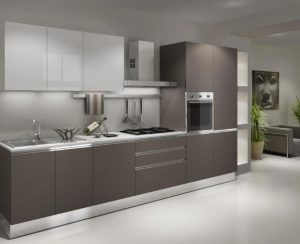Kitchen cabinets are an essential element of any kitchen, providing storage and style. If you’re curious about how these cabinets are made, you’ve come to the right place. In this article, we’ll take a detailed look at the process of making kitchen cabinets, from the materials used to the techniques employed.
Materials Used in Kitchen Cabinet Production The first step in making a kitchen cabinet is selecting the materials. The most common materials used in the production of kitchen cabinets are wood, MDF, and particleboard. Each of these materials has its pros and cons. Wood, for example, is a classic choice that provides a natural and elegant look. However, it is also the most expensive option. MDF is a cheaper alternative that is durable and resistant to warping, but it doesn’t have the same natural look as wood. Particleboard is the most cost-effective option, but it is not as durable as wood or MDF.
Design and Measurements Once the materials are selected, the next step is to design the cabinets. The design should take into account the size and layout of the kitchen, as well as the intended use of the cabinets. The measurements must be precise to ensure that the cabinets fit perfectly in the space. The design and measurements are critical to ensure that the cabinets are functional and aesthetically pleasing.
Cutting the Materials The next step is to cut the materials. This process involves using a saw to cut the wood, MDF, or particleboard into the required shapes and sizes. The saws used in this process include table saws, circular saws, and jigsaws. The cutting process must be accurate to ensure that the pieces fit together correctly.
Assembly and Joinery Once the materials are cut, the next step is to assemble the cabinet. This process involves joining the pieces of wood, MDF, or particleboard together using a variety of techniques. The most common techniques include dowel joinery, pocket-hole joinery, and mortise and tenon joinery. The type of joinery used will depend on the design and materials used. The joinery must be strong and secure to ensure that the cabinets are sturdy and long-lasting.
Finishing Once the cabinets are assembled, the next step is to finish them. The finishing process involves sanding the cabinets to ensure that they are smooth and free of any imperfections. After sanding, the cabinets are ready to be painted or stained. The finishing process is critical to ensure that the cabinets look great and are protected from moisture and wear.
Installation The final step in making kitchen cabinets is installation. This process involves fitting the cabinets into the space and attaching them to the walls. The installation process must be precise to ensure that the cabinets are level and secure.
Conclusion In conclusion, making kitchen cabinets is a complex process that requires careful attention to detail. From selecting the materials to installation, every step must be done with precision to ensure that the cabinets are functional and aesthetically pleasing. By understanding the process of making kitchen cabinets, you’ll have a greater appreciation for the work that goes into these essential elements of any kitchen.




